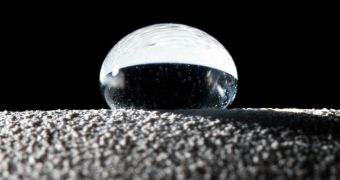Just yesterday, scientists with the Brigham Young University in the United States announced the development of super-hydrophobic surfaces that they say can help make energy generation both cleaner and more efficient.
In a paper published in the journal Physics of Fluids, the Brigham Young University researchers detail that the surfaces in question sport a hydrophobic coating and display a pattern of microscopic ridges or posts.
They go on to explain that, courtesy of their makeup, the surfaces repel water to such an extent that, under certain circumstances, they make it bounce off them just like a ball would, as noticeable in the photo above.
The scientists who worked on this research project argue that, all things considered, such surfaces could be used to make better ships, torpedoes or submarines, and even aircraft wings that can better withstand humid conditions.
However, the Brigham Young University specialists are first and foremost interested in using their super-hydrophobic surfaces to make energy generation a wee more environmentally friendly.
In their paper in the journal Physics of Fluids, they explain that many power plants work by burning coal and natural gas to create Steam that in turn sets turbines in motion. Once its job is done, the steam gets condensed and cycled back.
The researchers argue that, should the condensers that coal and natural gas power plants employ be made with super-hydrophobic materials, the process of recovering steam and turning it into a liquid form would be faster and more cost-effective.
“If you have these surfaces, the fluid isn’t attracted to the condenser wall, and as soon as the steam starts condensing to a liquid, it just rolls right off. And so you can very, very quickly and efficiently condense a lot of gas.”
It is believed that, by compelling the steam to condense faster, such surfaces would not only boost the efficiency of coal and natural gas plants, but would also help lower the costs associated with energy generation.
The super-hydrophobic surfaces created by the Brigham Young University specialists are not yet ready for use in real-life conditions. The specialists are busy testing them in the laboratory, and hope that they will soon establish which surfaces are best suited for one application or another.
“Our research is geared toward helping to create the ideal super-hydrophobic surface. By characterizing the specific properties of these different surfaces, we can better pinpoint which types of surfaces are most advantageous for each application,” explains mechanical engineering professor Julie Crockett.

 14 DAY TRIAL //
14 DAY TRIAL //